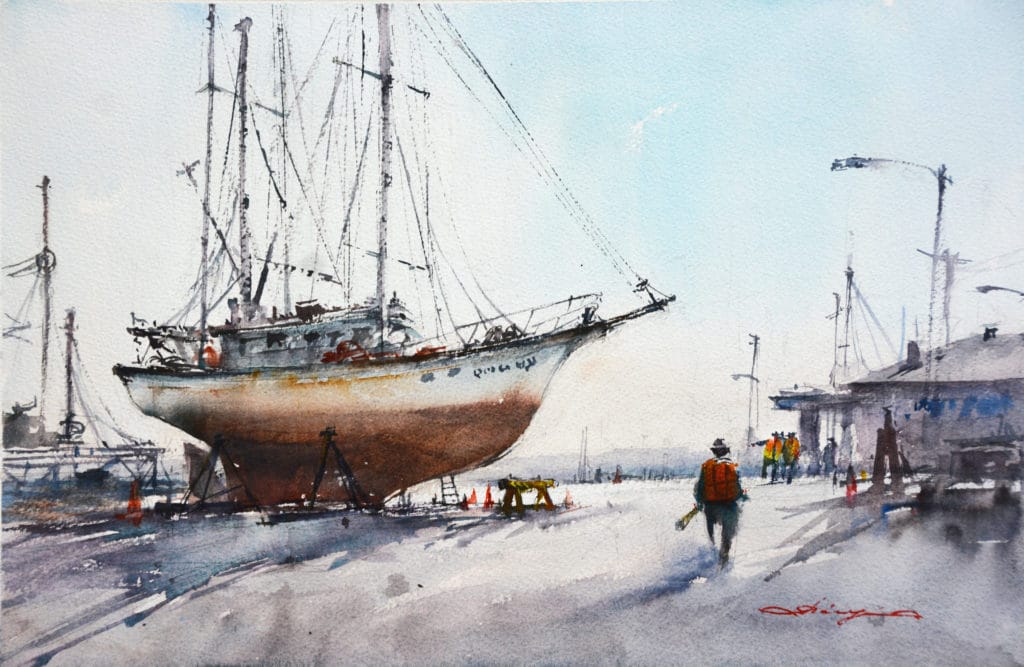
“Painting the landscape is not about duplicating every detail or copying the specific features of a location exactly,” says watercolor artist Shuang Li. As artists, our job is to interpret a scene, using the visual language of our craft — the elements of design: line, shape, color, value, and texture. By carefully observing nature, we can train our eyes to see these visual elements at work and find the clearest way to express our creative vision in a painting.

Elements of Design for Watercolor Artists:
Line: Manipulating the movement of visual elements within a scene can lead the viewer’s eye to specific areas and create a better visual flow than what is actually present.
• Curved lines suggest comfort and ease
• Horizontal lines suggest distance and calm
• Vertical lines suggest height and strength
• Jagged lines suggest turmoil and anxiety
Shape: Adjusting the relative width and height of objects can affect proportions, changing how we relate to them. Shapes can be used to control your feelings in the composition of an artwork.
• Squares and rectangles can portray strength and stability
• Circles and Ellipses can represent continuous movement
• Triangles can lead the eye in an upward movement
• Inverted Triangles can create a sense of imbalance and tension
Color: Altering the color scheme, or using primarily a warm or cool color palette, can establish a particular mood or atmosphere. We can also use color to create:
• harmony and balance
• light
• pattern
• form
• symbols
• movement
• contrast
Value: Varying the placement of lights and darks within the composition can alter the character of the scene. Value can be used to create:
• contrast
• the illusion of form
• a dramatic or tranquil atmosphere
• a sense of depth and distance
• a rhythm or pattern within a composition
Texture: Accentuating the perception of texture can create rhythm and emphasis. Texture can be created with:
• expressive brushstrokes
• spattering
• blossoms
• applying salt
• drybrush techniques
Born, raised, and classically trained in China, California-based watercolor artist Shuang Li moved to the United States 30 years ago. Shuang paints watercolor both on location and in her studio, portraying the extraordinary variety of life with her unique perspective. With masterful classic and contemporary techniques, she recreates nature’s beauty in her paintings by capturing moods and moments of light with her singular poetic expression. Shuang is a signature member of National Watercolor Society, San Diego Watercolor Society, Watercolor West and elected Artist Member of California Art Club.
Shuang Li shares her process for painting compelling waterscapes in the DVD, “FEARLESS WATERSCAPES WITH SHUANG LI.”








I love this newsletter. The articles are informative without being the same old boring stuff!
Greetings from Ireland. Now retired, I’m merely dabbling in watercolour since last year and making VERY slow progress, but I love your regular newsletter with such interesting articles and links to other resources. I wish you all well with the publication: keep up the good work!
A good publication that addresses the concerns of watercolours, very informative and an enjoyable read.
Always enjoy reading a new perspective that I had not considered. Variation is endless.
Nice article. I’m a strong advocate of Edgar Whitney’s Elements and Principles of Design. Unfortunately, every other artist alters these points, changing “Conflict” to Contrast”, etc.
Having taken two workshops with Shuang Li, this article Guide to composition was a nice way to sum up the topics covered in the class. Thank you Shuang. I so enjoy receiving this newsletter.
Very educative. Thanks for sharing